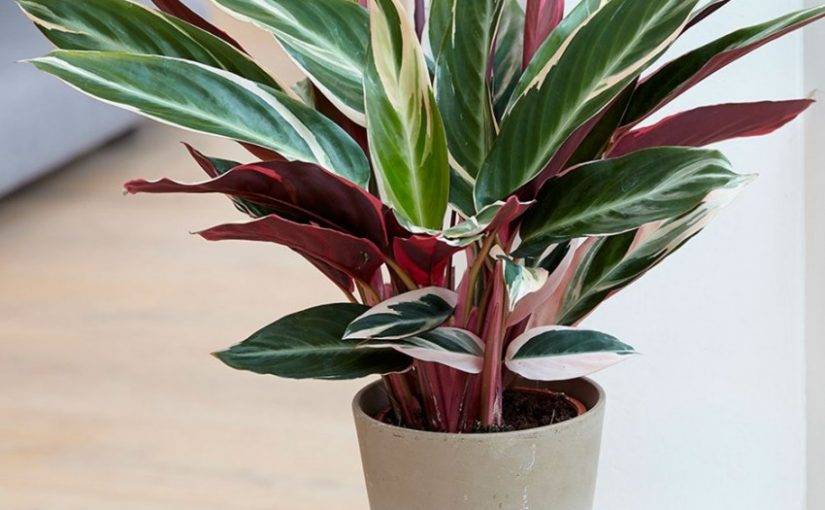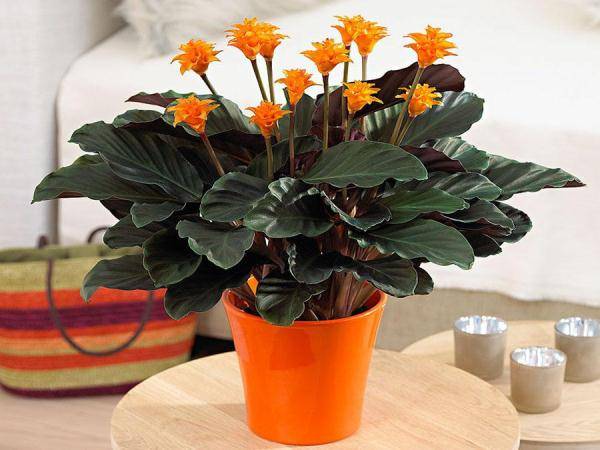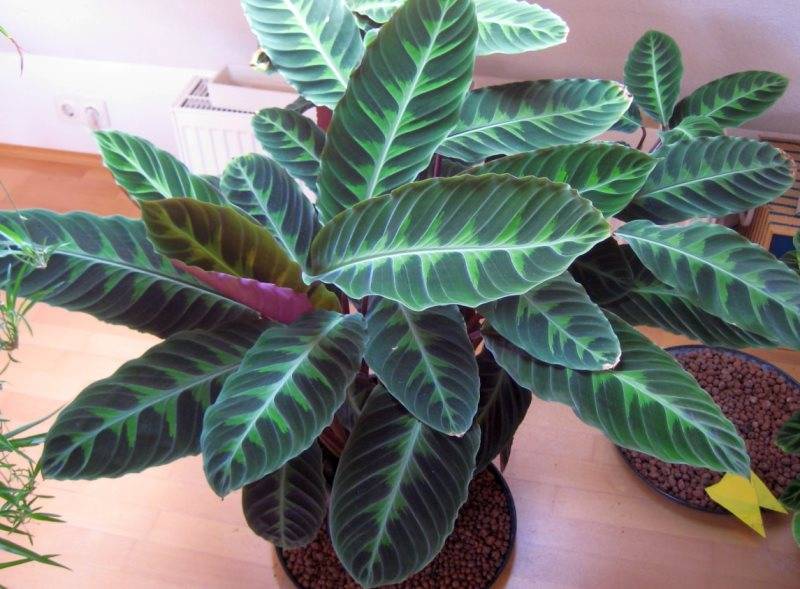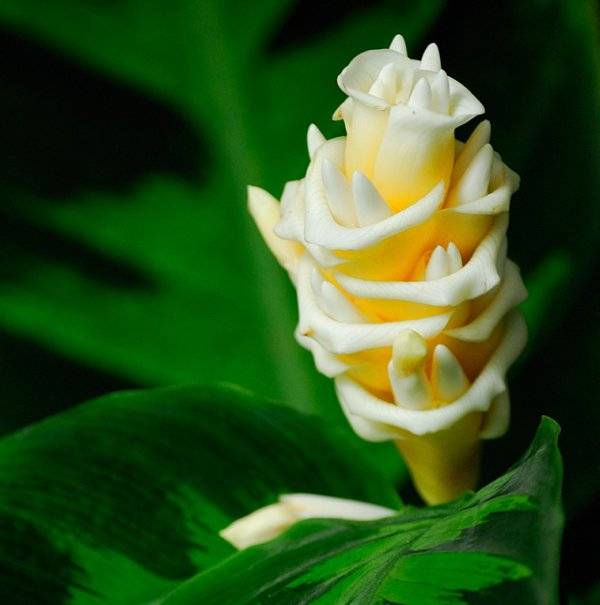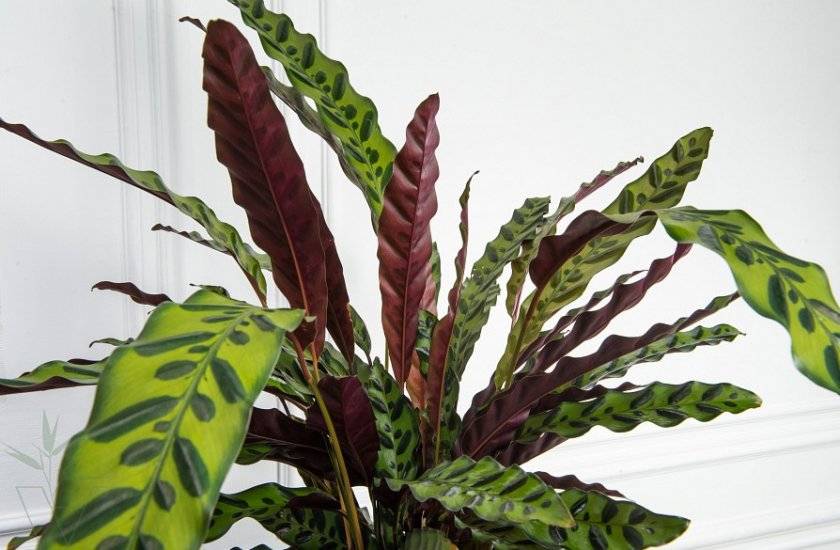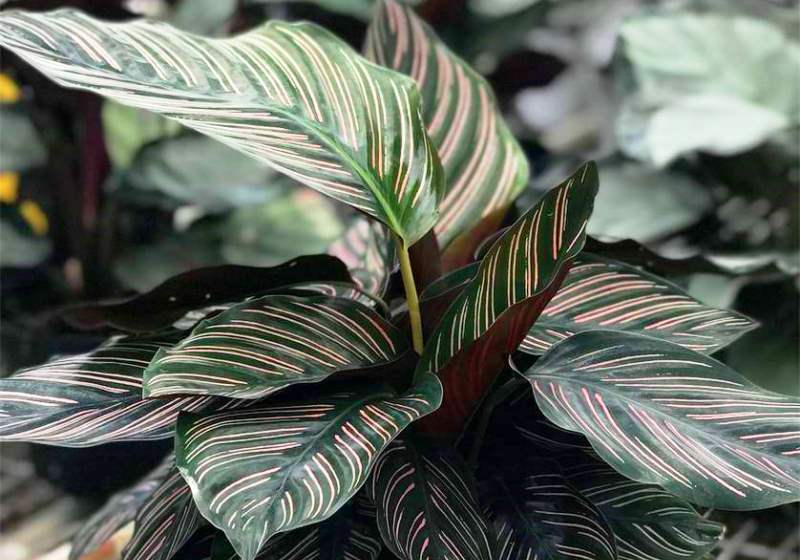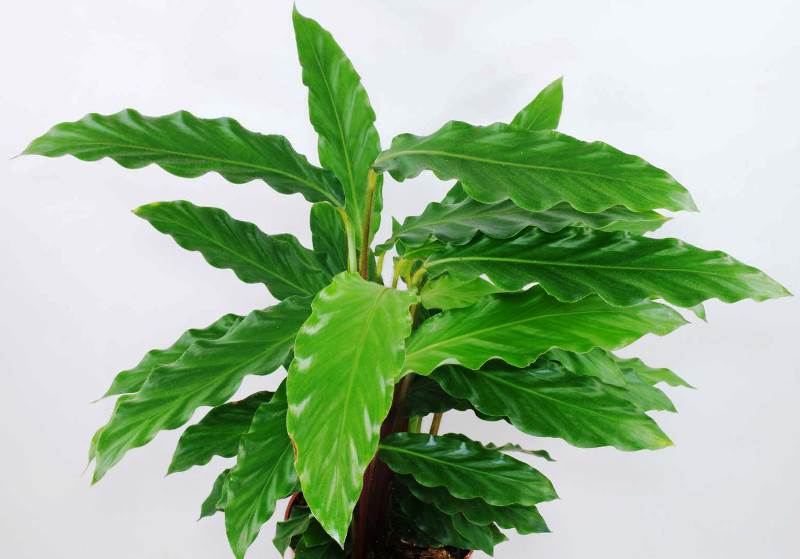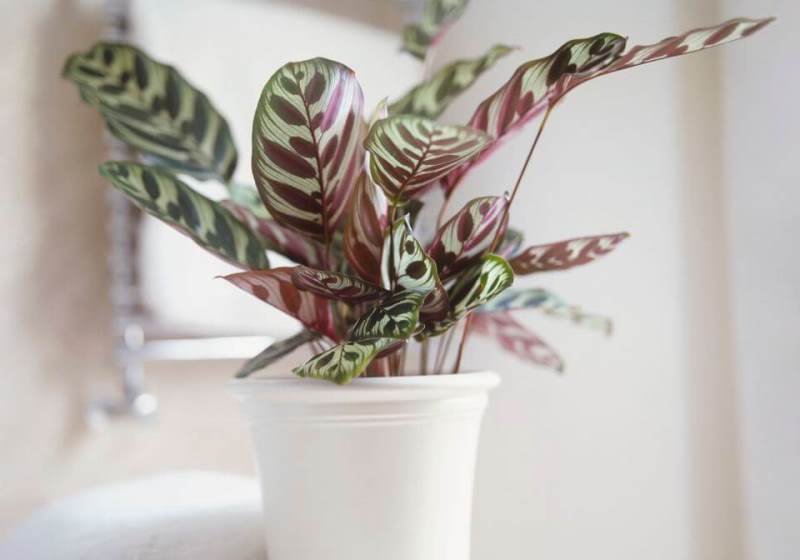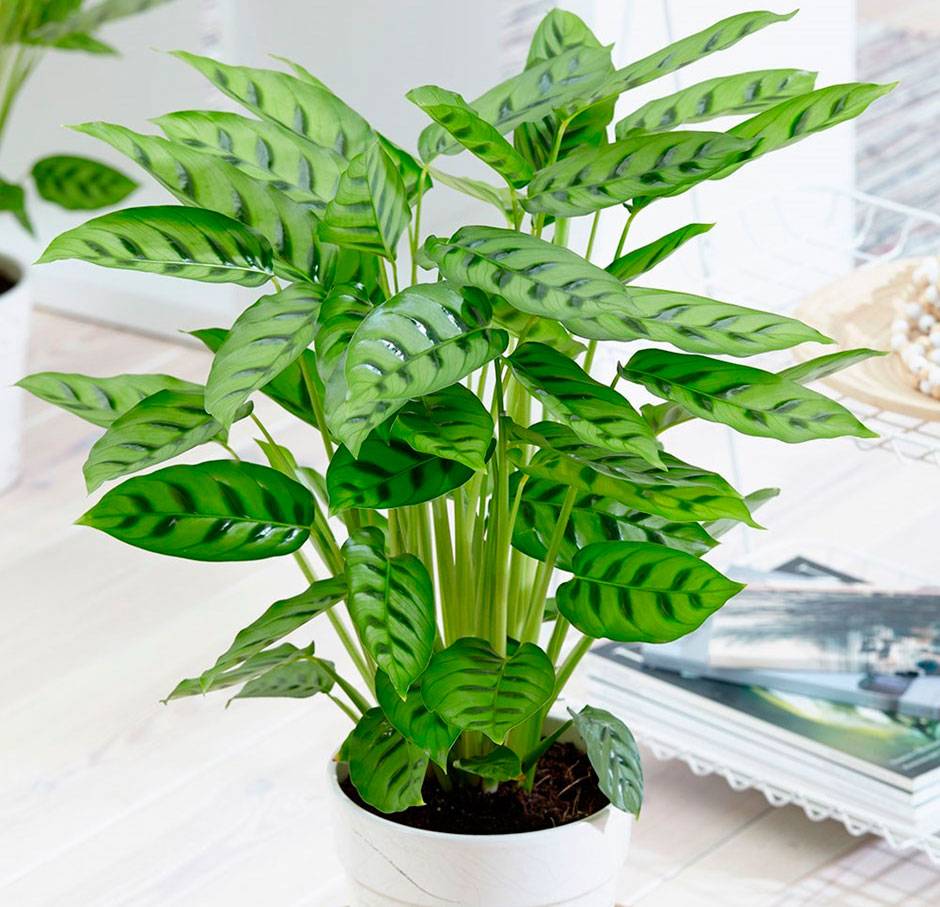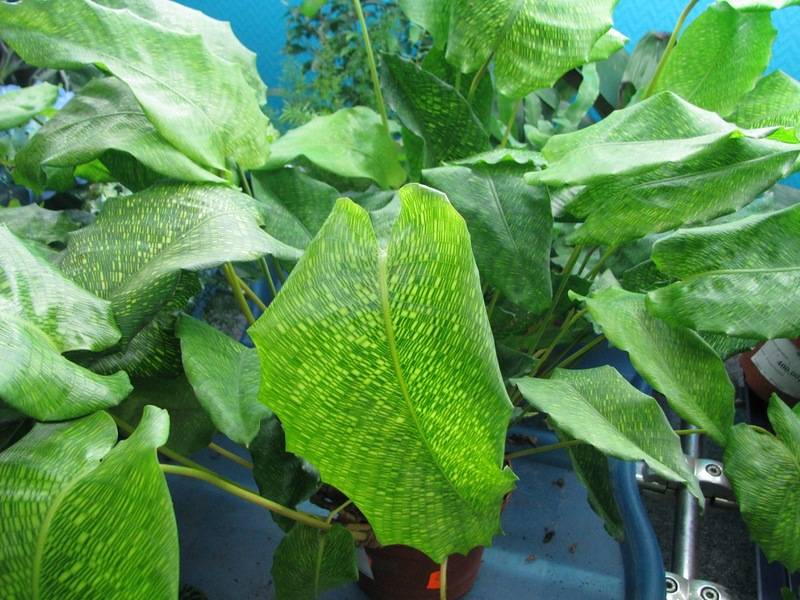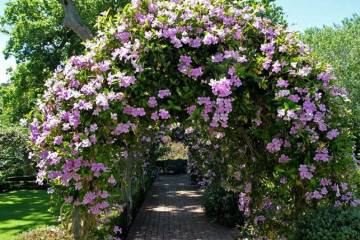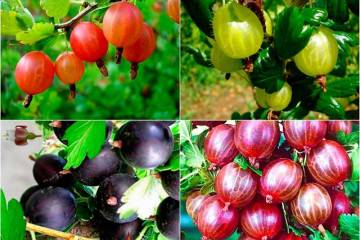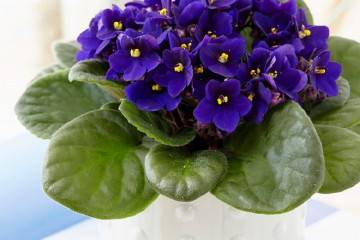Calathea flower - description of the Medallion and Crocata species
Content:
Indoor flower Calathea, belonging to the Marantov family, is known for its unusually beautiful leaves and picturesque inflorescences. The name of the plant comes from the ancient Greek word "Kalathos", which translated into Russian means "basket" (in ancient times, baskets were woven from the bark of a plant).
Description of the flower
Currently, calathea has more decorative value than practical. Indoor plant is represented by numerous species, among which are very popular with flower growers:
- Medallion;
- Crocata;
- Varshevich;
- Lancifolia;
- Sanderian;
- Orbifolia;
- Rufibarba;
- Makoya;
- Roseopicta;
- Leopardina, etc.
Almost all types of calathea reach 75 cm in height, have large oval leaves, the length of which is 25-30 cm. Basically, the leaves have petioles, but there are species with lanceolate leaf shapes. Plants grow in rosettes, the number of which can vary within different limits.
Popular types
Most often, flower growers choose the following varieties.
Calathea Medallion
Northwestern Brazil is considered the homeland of this variety. The plant grows up to 40 cm. It is a very beautiful flower with a unique texture, the leaves of which have a double color: the upper side is dark green with thin silvery veins, and the lower part is purple.
This calathea species is very sensitive to light. In the morning, the leaves of the plant go down, and in the evening they go up, thus emphasizing their originality.
This variety of indoor flower is a delicate plant, so gardeners recommend growing it in a warm, sunny room with a high level of humidity. In summer, it is not recommended to take the Medallion out to the balcony or garden.
During transplantation, old and dried leaves are cut off from the flower; the roots cannot be touched. The instrument that will be used for pruning is disinfected with hydrogen peroxide.
A photosensitive plant needs enough light. Lighting should be soft, diffused. During summer sunny days, the flower should be shaded, avoiding direct sunlight on the leaves. But the lack of light also badly affects the plant, in which case the variegated color of the leaves disappears, and the calathea loses its decorative properties.
In winter, Calathea Medallion must be provided with additional artificial lighting (for example, ordinary electric lamps, which will extend the daylight hours).
It is necessary to water the Medallion variety in moderation, as soon as the topsoil dries out. In summer, it is often and abundant, in winter, once a week is enough. In the hot season, the plant is additionally irrigated with warm, settled water.
The soil for planting a plant must be loose, free of lime. This is important when choosing a substrate at a flower shop.Frequent transplants harm calatheas, for an adult plant such a procedure should be carried out no more than once every 2 years, young plants can be transplanted annually. For feeding, use a liquid fertilizer for deciduous ornamental plants.
Reproduction of Calathea Medallion is carried out with the help of seeds, cuttings and division of the rhizome. The latter method is a popular breeding method for calathea among flower growers.
Calathea Crocata (saffron)
Among the many varieties of kalatei, the Crokat species certainly stands out for its decorative properties. The flower will decorate any room, both at home and in the office. This perennial plant looks like a man-made plant with yellow buds. The plant has a second name - saffron calathea.
This variety has a dark green leaf color on one side and almost brown on the other. Leaves are smooth, large, slightly wavy at the edges. The original pattern, characteristic of all species of the genus, is less pronounced than that of other representatives.
Calathea Crocata blooms in winter (January-February) with bright yellow inflorescences and is the only variety blooming in winter among other species of calathea.
This variety is a demanding plant, and inexperienced growers will not be able to provide the Calathea Crokat plant with the necessary care at home. The plant loves warm humid air at least 19 ° C.
Some growers do not like to grow saffron calathea because of the specific aroma of flowers, considering it repulsive.
Calathea Varshevich
This calathea variety is a beautiful plant with abundant flowering, but very moody at home. Only experienced flower growers can take care of room calathea. The plant is demanding for frequent systemic watering, bright light and additional feeding.
A large perennial has short stems and long, large leaves tied in small rosettes. The length of the leaf with a petiole reaches 20-55 cm, it is oval in shape with a double surface. The reverse side of the leaf has a brown tint.
In the period from May to July, Calathea blooms profusely, the flowers are large beige or white.
Calathea Lancifolia
A variety of this type of culture has underground shoots that form rhizomes, the rosettes of the leaf plates contain one leaf each. The plant grows up to 75 cm in height. Leaves are renewed every year, old ones die off and are replaced with new ones.
The plant has a variegated color. The outer part of the leaf is green with symmetrical black spots, the back is purple.
With the right content, flowering occurs from May to August. The color of flowers is lilac, white, red.
In many authoritative editions, this story with the names is explained as follows: Calathea is wonderful - this is the first name of the variety, which was later renamed to Calathea Lancifolia. But both names can still be found in modern editions, and flower shops prefer to simply use RattleSnake.
Calathea Sanderian and Roseopictus
Confusion often occurs due to the different names of this species. The common name of the species Calathea Pinstripe in science is called Calathea Oranta. Translated from English and Latin, "oranta" means "decoration", hence another name for this species - decorated. The Pinstripe species includes several varieties that differ in insignificant color.The most popular are Sanderiana and Roseopikta.
Varieties of this species are characterized by a similar description of the appearance: plants 50-55 cm high, leaves are dense, shiny, oval in shape with pointed ends, have a pattern in the form of stripes, symmetrically diverging from the center of the leaf.
In keeping, the flower is unpretentious, loves fresh air, sunny procedures, watering and standard types of dressings.
Calathea Orbifolia
This variety of evergreen plant usually reaches a height of 50-70 cm, differs from other species in rather large leaves of light green color with silvery stripes. The plant is considered unpretentious in comparison with other varieties within its species. Even a novice gardener will not be difficult to take care of the Orbifolia calathea, the main thing is to remember that the plant does not like direct sunlight, excessive watering and dry air.
Calathea Rufibarba
This houseplant variety is a branchy shrub. The plant has satiny, narrow, slightly wavy emerald-colored leaves on one side and pink-lilac on the other. The back of the leaf and cuttings are covered with red down.
Plant height can reach 85-90 cm. Only experienced gardeners can grow this demanding indoor flower. The difficulties of keeping calathea lie in systemic watering, top dressing and continuous lighting (up to 14-17 hours per day).
A common reason why the leaves of an indoor shrub dry out is insufficient air humidity in the room. You can correct the situation by carefully spraying the leaves or adjusting the frequency and abundance of watering.
Rufibarba blooms with small inconspicuous flowers, collected in inflorescences in the form of spikelets of an amber-white hue.
Calathea Makoya
This type of calathea is a real capricious princess on the windowsill, the cultivation of which is recommended only to professional flower growers. The flower needs a special atmosphere and a certain humidity of the air, so a terrarium, florarium, winter and botanical gardens will be a suitable place for keeping.
This herbaceous perennial reaches 25-45 cm in height and width, the leaves are elongated, ovoid, thin, graceful, almost transparent. Florists choose this variety for its unusual color: the upper part of the leaf has an emerald color with snow-white strokes extending from the center of the leaf plate, on the seamy side the pattern is completely repeated, but has a raspberry tint.
Lilac miniature flowers are collected in dense inflorescences.
Calathea Leopardina
Calathea Leopardina is a low plant up to 40-50 cm tall. It differs from other species in lanceolate oval leaves on long petioles. The outer side of the leaf is light green with dark green spots, repeating the structure of the leaf. The drawing resembles a drawn twig. The back of the leaf is lilac-pink.
Inflorescences are small, spike-shaped, yellow.
Calathea Mosaic
Calathea Network (Mosaic) is a miniature houseplant that differs from the rest of this species in the color of the leaf plate. Leaves are dense, large and slightly elongated. The color of the leaf resembles a lined glass mosaic or a fishing net woven from dense yarn.
Other plant varieties:
- Calathea White (Majestic) can grow up to 1 m in height with large lanceolate leaves. The lower part of the leaf is beet-red;
- calathea Queen of Maui - a variety of the Louise variety, a rather spectacular plant with large leaves, there is a pattern in the form of spikelets along the entire length of the leaf;
- Calathea Lubbers differs from other representatives of the species by an atypical color of the leaf, the pattern is chaotic, consists of yellow spots of different sizes. In addition, the back of the plant is not reddish or purple, but green;
- Calathea Bahema is one of the most unpretentious among the rest of the varieties. It grows up to 40 cm, the leaves are lanceolate with a pattern that resembles a neat twig;
- Calathea Misto is distinguished by a pattern on the leaves, consisting of light strokes painted on a pale green background. The patterns are more graceful than other species.
Also, among gardeners, other varieties of indoor ornamental shrubs are popular (Vitat's calathea, Burle Marx, Veich, Zebrin, etc.).
The described most popular types of decorative kalata with unique bright patterns, evergreen shrubs from miniature to large sizes are not always available for novice gardeners, but among a wide variety of species, everyone can choose a suitable plant. All varieties share two key conditions: high humidity and sunlight. Having created the right conditions for a flower, he will surely thank you with an amazing appearance.
